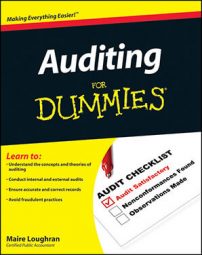In addition to being thorough and unbiased when evaluating audit evidence, you also want to apply professional judgment by adopting an attitude of professional skepticism. When exercising professional skepticism, you keep an open and reasonably questioning mind without being overly suspicious. You don’t assume that management is dishonest, and you don’t assume that it’s honest. You always keep it in the back of your mind that fraud can be present.
When audit evidence is less than persuasive, this mind-set leads you to expand your questioning. It encourages you to analyze whether the evidence is misleading or simply incomplete. Use your answer to this question to make a potential fraud assessment. Then, tailor more probing questions and follow up by critically analyzing the client’s response.
Follow these four guidelines when applying professional skepticism while you’re gathering and evaluating the client’s audit evidence:
Don’t ever forget that fraud can exist in any audit.
Set aside any notions you may have developed while interviewing management. Regardless of how honest and ethical management may seem to be, fraud can still be present.
While you’re gathering evidence, always review it with the mind-set that it could possibly be fraudulent.
Make sure to follow up with any less-than-persuasive evidence by asking more questions and examining more records if need be.
Here’s an example of the show me technique: If you don’t understand what a client is laying down on the table, meddling through the documents or the logic is a waste of time. Instead, you should ask for a thorough walkthrough of the procedure with documents to substantiate the client’s position. For instance, some clients just love to inflate revenue. Matching shipping documents to sales invoices is a common test for revenue. One method clients may use to prematurely book revenue is shipping to controlled destinations.
If you have a client that ships to a freight forwarder, you may have a fraudulent situation in which your professional skepticism comes in handy. A freight forwarder accepts shipments but doesn’t forward them to the customer until the client says the customer is ready to accept shipment. Until title of the goods is actually passed to the customer, your audit client doesn’t have a completed revenue transaction.
In this situation, you would ask the client more probing follow-up questions regarding the carrier to show you that this is indeed a complete transaction. You want to ask more questions about the carrier, ask the client to reconcile the shipping address to the customer’s delivery address, and ask whether the client owns or rents a warehouse at the shipping location. This last fact is often easy to verify by looking at assets and expenses on the financial statements. An owned warehouse will be listed on the balance sheet as a fixed asset. Warehouse rental shows up on the income statement under rent expense.

